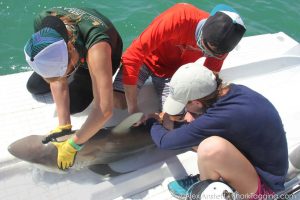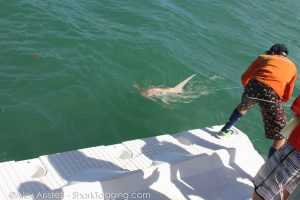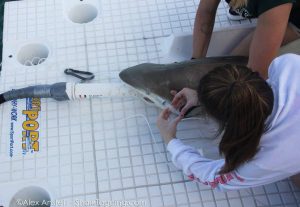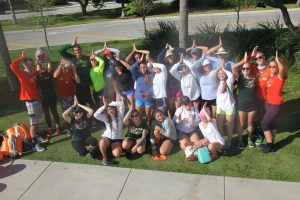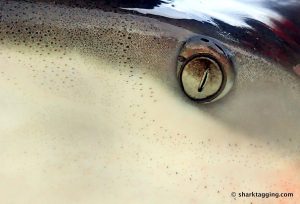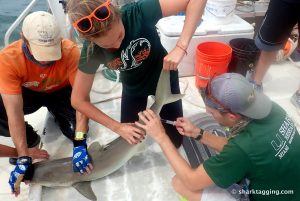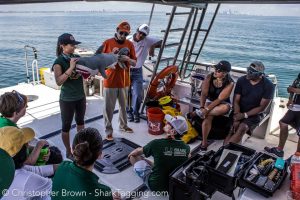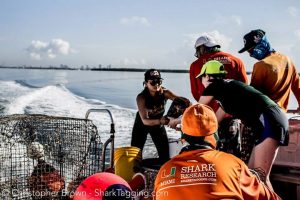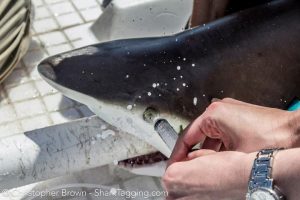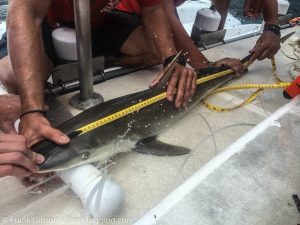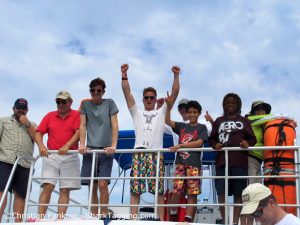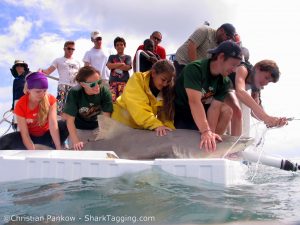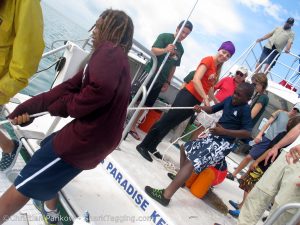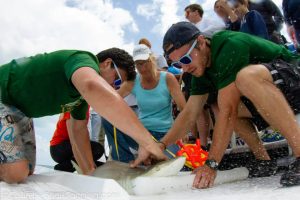Shark Tagging with South Broward High School
By Grace Roskar, SRC Intern
The morning of February 12th, 2016 was a beautiful day for the SRC team, the Diver’s Paradise captain and crew, and students of South Broward High School to set out for a day of shark tagging. We also had two citizen scientists on board, ten-year-old Tristan and his father Jivan from North Carolina. South Broward has been a participating school group of SRC for several years, and after enduring traffic from the Miami Boat Show, the group was anxious to board the boat and embark on a day of science, sharks, and sunshine.
The waters were calm as we motored out to a certain location among the group of shallow tidal flats known as the Safety Valve in Biscayne Bay. Drumlines were prepared with tuna or jack for bait and set out to let soak for an hour. Many of the South Broward students had been on an SRC trip before, but they were still eager to listen to trip leader Jake’s demonstration of the workup process for a shark. They were already knowledgeable about different shark species, as well as how they breathe by swimming to actively force water through their mouths and over their gills, allowing for the uptake of oxygen, in a process known as ram ventilation.
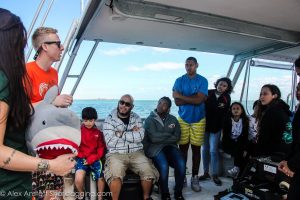
Trip leader and SRC Master’s student Jake tells students about the workup process for a shark and uses Sharky, the stuffed shark, to demonstrate the procedures
After an hour had passed, we set out to retrieve the first set of ten drumlines. On one line was a blacknose shark, which is a smaller species that SRC does not encounter often. This blacknose was a male and about 119 centimeters long, or a little shorter than 4 feet. Due to its small size, Jake and Rock brought the shark directly onto the back of the boat instead of setting up our large platform, and it was safely secured on deck. Next, our citizen scientists and South Broward students assisted the SRC team with a nictitating membrane test to test the shark’s stress levels, several length measurements, taking a sample of the dorsal fin, and inserting a dart tag into the shark’s dorsal fin. Rock took morphological measurements and Hannah swiftly drew blood from the caudal vein of the shark, to be used for several different measurements such as glucose and hematocrit levels, which is valuable data for Jake’s ongoing Master’s thesis. After a quick workup, students were able to take a few moments to touch the shark and feel its dermal denticles, which are scales that are basically modified teeth, as dermal denticles means “small skin teeth.”
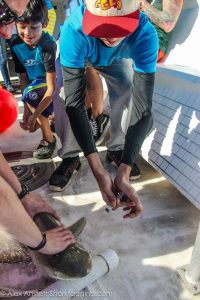
A South Broward student quickly pumps seawater into the shark’s eye to watch for its ‘eyelid’, called a nictitating membrane, to pop up. This reflex is a possible measure of stress levels in the animal.
The blacknose shark was quickly and safely released, and we moved on to set out to retrieve the rest of the drumlines. There were no more sharks on the lines, so they were set out for two more sets. While pulling up one line, Jake felt tension for a moment, thinking it could be a shark, but then the line was released and the tension dissipated. It is possible there was a shark on the line but was not hooked completely and was able to get away. Even with some South Broward students choreographing their own “shark dance” in hopes of good luck, after thirty lines, we had only caught the one shark. With hopes still high, we had time to set out five more lines, but trip leader Jake and Captain Eric decided to try a new spot. We motored closer to Stiltsville, a group of houses built on stilts in a different part of the general area of the Safety Valve. We quickly set out five more baited drumlines and let them soak for about forty-five minutes. To our delight, another blacknose was hooked! It was carefully brought onto the back deck of the boat and secured by Jake and Rock. Our trip guests helped again with the nictitating membrane test, measuring the shark, taking a fin clip, and tagging the shark. Hannah was able to successfully draw blood once more and I helped with morphological measurements, including the span of the shark, clasper measurements, and taking pictures of its fins to be digitized for scale to see how sharks grow over time.

Tristan and Jivan, our citizen scientists for the day, help insert a spaghetti tag into the sharks dorsal fin.
After thirty-five lines, the team and students were elated and grateful to have caught two blacknose sharks, which is a more rare occasion on the SRC boat! With beautiful weather all day, it was overall an exciting day on the water with South Broward High School and our citizen scientists. Although many South Broward students had been on a trip with us before, their excitement to learn about and see these apex predators never faltered. We were honored to have Tristan and Jivan onboard with us and were grateful for their help throughout the day. The SRC team gathered valuable data from the two blacknose sharks and we hope that South Broward will come out with us again soon!

